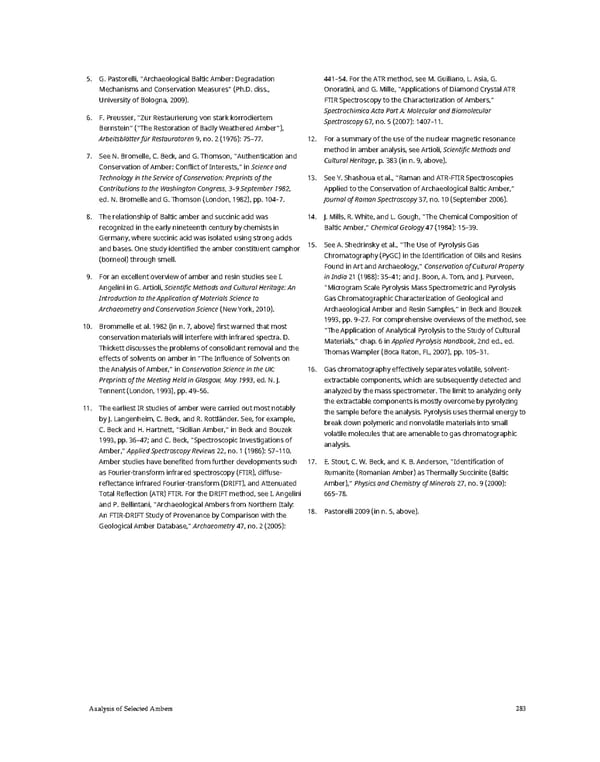5. G. Pastorelli, “Archaeological Baltic Amber: Degradation 441–54. For the ATR method, see M. Guiliano, L. Asia, G. Mechanisms and Conservation Measures” (Ph.D. diss., Onoratini, and G. Mille, “Applications of Diamond Crystal ATR University of Bologna, 2009). FTIR Spectroscopy to the Characterization of Ambers,” Spectrochimica Acta Part A: Molecular and Biomolecular 6. F. Preusser, “Zur Restaurierung von stark korrodiertem Spectroscopy 67, no. 5 (2007): 1407–11. Bernstein” (“The Restoration of Badly Weathered Amber”), Arbeitsblätter für Restauratoren 9, no. 2 (1976): 75–77. 12. For a summary of the use of the nuclear magnetic resonance 7. See N. Bromelle, C. Beck, and G. Thomson, “Authentication and method in amber analysis, see Artioli, Scientific Methods and Conservation of Amber: Conflict of Interests,” in Science and Cultural Heritage, p. 383 (in n. 9, above). Technology in the Service of Conservation: Preprints of the 13. See Y. Shashoua et al., “Raman and ATR-FTIR Spectroscopies Contributions to the Washington Congress, 3–9 September 1982, Applied to the Conservation of Archaeological Baltic Amber,” ed. N. Bromelle and G. Thomson (London, 1982), pp. 104–7. Journal of Raman Spectroscopy 37, no. 10 (September 2006). 8. The relationship of Baltic amber and succinic acid was 14. J. Mills, R. White, and L. Gough, “The Chemical Composition of recognized in the early nineteenth century by chemists in Baltic Amber,” Chemical Geology 47 (1984): 15–39. Germany, where succinic acid was isolated using strong acids 15. See A. Shedrinsky et al., “The Use of Pyrolysis Gas and bases. One study identified the amber constituent camphor Chromatography (PyGC) in the Identification of Oils and Resins (borneol) through smell. Found in Art and Archaeology,” Conservation of Cultural Property 9. For an excellent overview of amber and resin studies see I. in India 21 (1988): 35–41; and J. Boon, A. Tom, and J. Purveen, Angelini in G. Artioli, Scientific Methods and Cultural Heritage: An “Microgram Scale Pyrolysis Mass Spectrometric and Pyrolysis Introduction to the Application of Materials Science to Gas Chromatographic Characterization of Geological and Archaeometry and Conservation Science (New York, 2010). Archaeological Amber and Resin Samples,” in Beck and Bouzek 10. Brommelle et al. 1982 (in n. 7, above) first warned that most 1993, pp. 9–27. For comprehensive overviews of the method, see conservation materials will interfere with infrared spectra. D. “The Application of Analytical Pyrolysis to the Study of Cultural Thickett discusses the problems of consolidant removal and the Materials,” chap. 6 in Applied Pyrolysis Handbook, 2nd ed., ed. effects of solvents on amber in “The Influence of Solvents on Thomas Wampler (Boca Raton, FL, 2007), pp. 105–31. the Analysis of Amber,” in Conservation Science in the UK: 16. Gas chromatography effectively separates volatile, solvent- Preprints of the Meeting Held in Glasgow, May 1993, ed. N. J. extractable components, which are subsequently detected and Tennent (London, 1993), pp. 49–56. analyzed by the mass spectrometer. The limit to analyzing only 11. The earliest IR studies of amber were carried out most notably the extractable components is mostly overcome by pyrolyzing by J. Langenheim, C. Beck, and R. Rottländer. See, for example, the sample before the analysis. Pyrolysis uses thermal energy to C. Beck and H. Hartnett, “Sicilian Amber,” in Beck and Bouzek break down polymeric and nonvolatile materials into small 1993, pp. 36–47; and C. Beck, “Spectroscopic Investigations of volatile molecules that are amenable to gas chromatographic Amber,”Applied Spectroscopy Reviews 22, no. 1 (1986): 57–110. analysis. Amber studies have benefited from further developments such 17. E. Stout, C. W. Beck, and K. B. Anderson, “Identification of as Fourier-transform infrared spectroscopy (FTIR), diffuse- Rumanite (Romanian Amber) as Thermally Succinite (Baltic reflectance infrared Fourier-transform (DRIFT), and Attenuated Amber),”Physics and Chemistry of Minerals 27, no. 9 (2000): Total Reflection (ATR) FTIR. For the DRIFT method, see I. Angelini 665–78. and P. Bellintani, “Archaeological Ambers from Northern Italy: 18. Pastorelli 2009 (in n. 5, above). An FTIR-DRIFT Study of Provenance by Comparison with the Geological Amber Database,” Archaeometry 47, no. 2 (2005): Analysis of Selected Ambers 283
 Ancient Carved Ambers in the J. Paul Getty Museum Page 292 Page 294
Ancient Carved Ambers in the J. Paul Getty Museum Page 292 Page 294